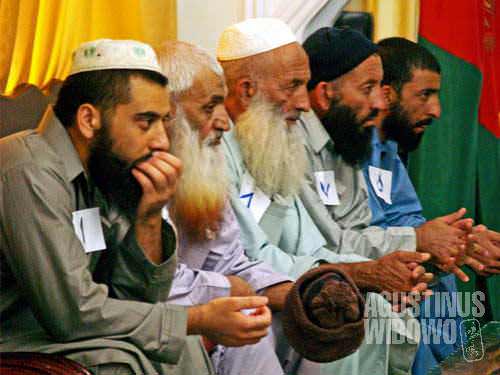Kabul – Nine Afghan Prisoners from Bagram

Prisoners released from Bagram
Nine Afghan prisoners, from various the provinces of Khost, Ghazni, Paktia, Balkh, and Farah, were released from the US military main airbase at Bagram today. They were in detention for various periods, from 8 months to two years, on the charge of having links to Taliban resurgent. I went there with a reporter to attend the ‘ceremony of freedom.’ I was expecting to see cruel faces of Taliban supporters, but what I saw was some thin old men with white beards, some younger bearded ones, all in Afghan dresses with Chinese luggage bags. Everybody was numbered from 1 to 9.
Haji Inayatullah, the eldest among the nine, a 76 year old man with white and red beard, was telling his unjustified detention in Bagram. The former Mujahidin commander loyal to Sibghatullah Mujaddidi was arrested and served one year in the American main airbase. Ironically, he was served the painful days in the detention center when he, following the government’s disarmament projects, was handling over 145 fire weapons and vehicles. His detention, he claimed, was unjust. He blamed the pro-Communist from Soviet era which now held high positions in his district, arranged everything as revenge to him as a former Mujahidin soldier – the enemy of the Communists.
The other prisoners, Hazrat Gul (74 years old), was arrested together with his two sons: Sattar Gul and Qadeer. They were picked up from their home, along with two sons and spirited away to a local US base before being shiftend to Bagram. They insisted they were kept in detention by the Americans without any charge.
While detention center in Guantanamo sees its end in near future, another detention center, less visible, is still holding hundreds of Afghans – the terror suspects, indefinitely and many without charges. This other hell is in Bagram, where a central clearing house for the global fight against terror is located. According to an article of the New York Times by Tim Golden and Eric Schmitt, the prisoners in Bagram have no access to lawyers, no right to hear the allegations against them, and only rudimentary reviews of their status as “enemy combatants”.
Haji Inaytullah might be telling his pain as an old man in the detention center in the most euphemistic way, but according to the New York Times report, men are held by the dozen in large wire cages, sleeping on the floor on foam mats, and until about a year ago, often using plastic buckets for toilets. The prisoners also had limited chance to see daylight just before recent renovation of the jail.
An editorial of the New York Times noted a parallel between torture of prisoners in Abu Ghraib (Iraq) and Bagram (Afghanistan):
What happened at Abu Ghraib was no aberration, but part of a widespread pattern. It showed the tragic impact of the initial decision by Mr. Bush and his top advisers that they were not going to follow the Geneva Conventions, or indeed American law, for prisoners taken in antiterrorist operations.
The investigative file on Bagram, obtained by The Times, showed that the mistreatment of prisoners was routine: shackling them to the ceilings of their cells, depriving them of sleep, kicking and hitting them, sexually humiliating them and threatening them with guard dogs – the very same behavior later repeated in Iraq.
See another tragedy revealed by Tim Golden:
Dilawar, who died on December 10, 2002, was a 22-year-old Afghan taxi driver and farmer who weighed 122 pounds and was described by his interpreters as neither violent nor aggressive. When beaten, he repeatedly cried “Allah!” The outcry appears to have amused U.S. military personnel, as the act of striking him in order to provoke a scream of “Allah!” eventually “became a kind of running joke,” according to one of the MP’s. “People kept showing up to give this detainee a common peroneal strike just to hear him scream out ‘Allah,’ ” he said. “It went on over a 24-hour period, and I would think that it was over 100 strikes.”
The Times reported that:
On the day of his death, Dilawar had been chained by the wrists to the top of his cell for much of the previous four days. “A guard tried to force the young man to his knees. But his legs, which had been pummeled by guards for several days, could no longer bend. An interrogator told Mr. Dilawar that he could see a doctor after they finished with him. When he was finally sent back to his cell, though, the guards were instructed only to chain the prisoner back to the ceiling. “Leave him up,” one of the guards quoted Specialist Claus as saying. Several hours passed before an emergency room doctor finally saw Mr. Dilawar. By then he was dead, his body beginning to stiffen. It would be many months before Army investigators learned a final horrific detail: Most of the interrogators had believed Mr. Dilawar was an innocent man who simply drove his taxi past the American base at the wrong time.
The old Haji Inayatullah may now start to live his normal life in his village. Kamaluddin (21 years old), the youngest among the nine, still had chance to rebuild his future. But there are still hundreds other of unlucky men there in Bagram who are serving unjustifiable trials. And whether Haji Inayatullah will not repeat his bad luck due to past-time enemies, nobody can assure.


Leave a comment